Every time you upload a media file, WordPress creates several copies. The extra files aren’t used anywhere on your website and can take up a lot of storage space on your hosting server.
We have been running a blog for a long time and have uploaded thousands of media files to WordPress. So, we know first-hand that cleaning up your media library can help optimize your site’s efficiency and performance. It can also help to keep your images organized.
In this article, we will walk you through three easy methods to clean up your WordPress media library. Our step-by-step instructions are super easy to follow, even if you are new to WordPress.
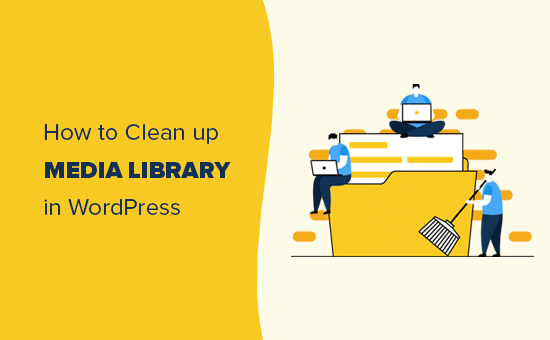
Why Clean Up WordPress Media Library?
When you upload an image, WordPress creates multiple image sizes by default. Some WordPress themes and plugins may also request additional image sizes.
These copies take up disk space on your web hosting server. They also increase the size of your WordPress backups, so it takes longer to back up, transfer, and restore your website. Depending on your hosting plan, you may even have to pay for extra storage.
You may be able to free up storage, create backups more quickly, and save money by cleaning up your media library and removing unused images.
Just be aware that cleaning up unused media files means deleting them forever. You can’t undo this, so make sure you create a complete WordPress backup before going any further.
With that done, let’s see how you can clean up the WordPress media library. Simply use the quick links below to jump straight to the method you want to use:
Method 1: Clean Up the WordPress Media Library Using Search & Replace Everything (Recommended)
The easiest way to find and remove unnecessary media files on your WordPress site is by using Search & Replace Everything.
Search & Replace Everything by WPCode is a powerful plugin that lets you easily find and replace both text and images across your WordPress site directly from your dashboard.
It also comes with an Unused Media Remover feature to help you quickly scan your entire WordPress database and remove any unnecessary images.
Note: There is a free version of the Search & Replace Everything plugin. However, you need the Pro version to access the Unused Media Remover.
First, you need to install and activate the Search & Replace Everything plugin. For more details, see our step-by-step guide on how to install a WordPress plugin.
Upon activation, go to the Tools » WP Search & Replace page from the WordPress dashboard.
From there, click on the ‘Remove Unused Media’ tab, and then hit the ‘Begin Scan’ button.
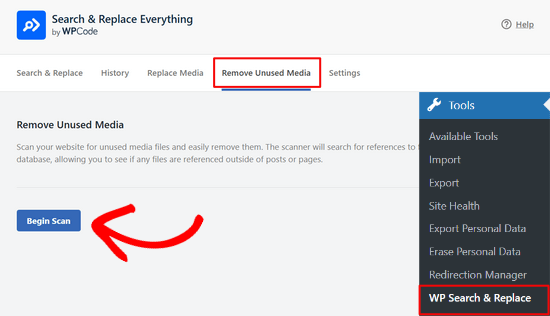
The plugin will then thoroughly scan your site’s entire database to make sure no files are missed.
The scan may take a few moments, but you can monitor its progress through the status bar.
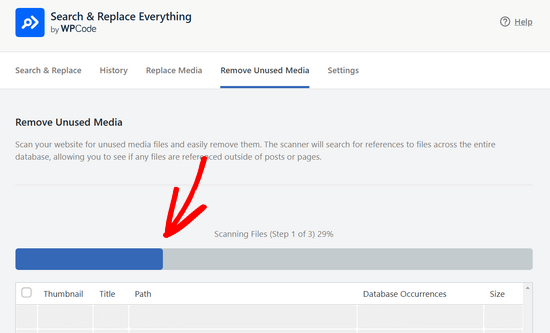
Once the scan is finished, you will see a list of unused media files that the plugin has found.
This list includes details like the image thumbnail, title, path, database occurrences, and size.
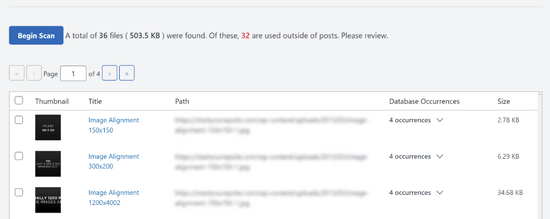
To remove the files, you can check the box next to each file you want to delete and click the ‘Delete Selected’ button at the bottom of the page.
Or, you can simply click the ‘Delete ALL’ button to delete all the files at once.
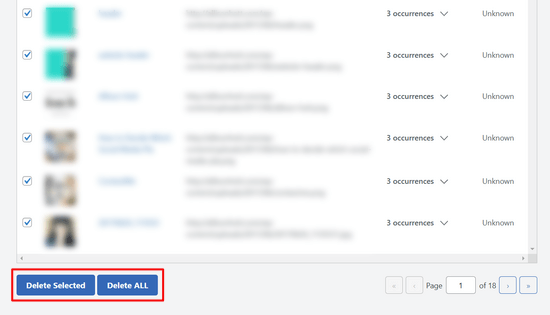
Method 2: Clean Up the WordPress Media Library Using Media Cleaner (Basic Cleanup)
You can also find and remove unnecessary media files on your WordPress site by using Media Cleaner. This free plugin focuses specifically on scanning your media library for unused files, unlike Search & Replace Everything, which scans your entire database.
First, you need to install and activate the Media Cleaner plugin. For more details, see our step-by-step guide on how to install a WordPress plugin.
Upon activation, head over to Meow Apps » Media Cleaner to analyze your WordPress media library.
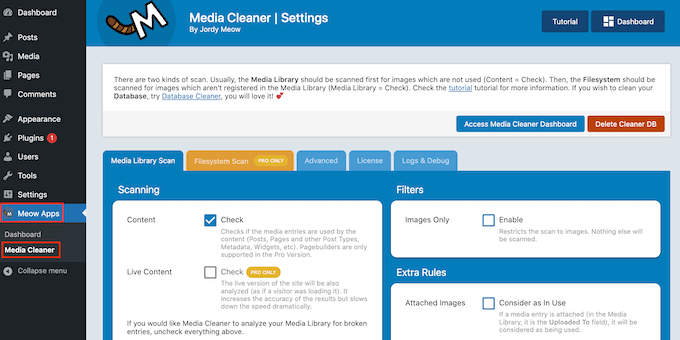
To start, we want to scan for image files that aren’t used by checking the box next to ‘Content.’
Then, go ahead and click on ‘Access Media Cleaner Dashboard.’
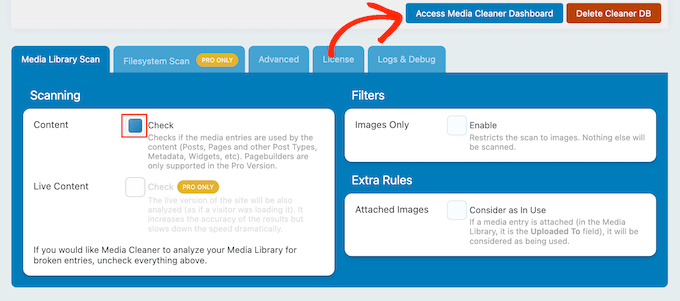
On the next screen, click on ‘Scan.’
After a few moments, Media Cleaner will show all the files it recommends you remove from the media library. It also displays the reason why it wants to remove each file from your WordPress blog.
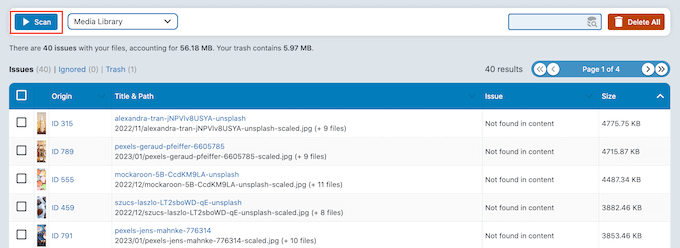
Simply go ahead and check the box next to each file that you want to permanently delete.
When you are ready, click ‘Delete’ to remove these files from your WordPress website.
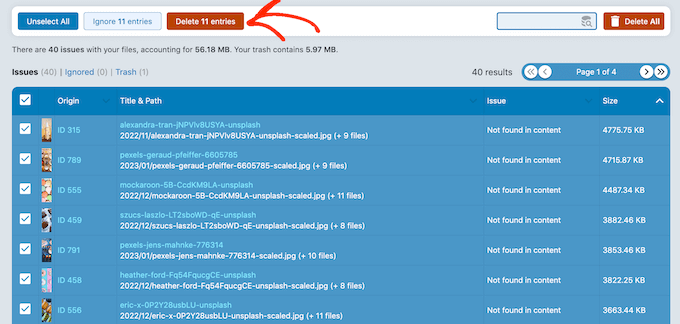
Method 3: Avoid Future Duplicate Images Using Media Deduper (Preventative Solution)
If you simply want to remove unnecessary media files from your library, then Search & Replace Everything is a great choice. However, if you want to avoid duplicate images in the future, then we recommend using Media Deduper instead.
This plugin automatically scans media files as you upload them to the media library and then flags any duplicates. However, the plugin does need to build an index of all your media files, so it takes a bit longer to set up.
First, you need to install and activate the Media Deduper plugin. For more details, see our step-by-step guide on how to install a WordPress plugin.
Upon activation, go to the Media » Manage Duplicates page from the WordPress dashboard and then click on the ‘Index Media’ button to analyze your media library.
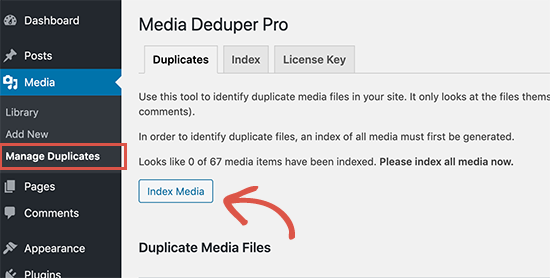
This can take a while, depending on the speed of your internet connection and the size of your media library.
When it’s finished, click on the ‘Manager Duplicates Now’ button that appears.
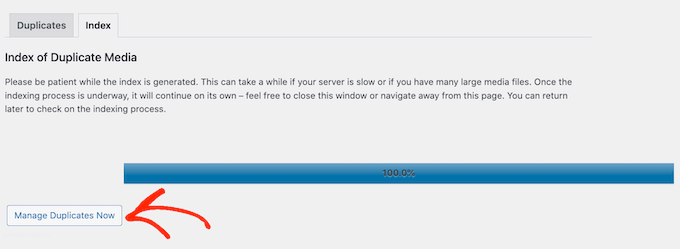
Media Deduper will now show all the unused and duplicate files that you may want to remove.
You can permanently delete any of these images, but we recommend using the Smart Delete feature instead.
If a post is using a duplicate file as a featured image, then Smart Delete will re-assign a different copy of that image before deleting the duplicate. From the visitor’s point of view, the post will still be using exactly the same featured image.
To use Smart Delete, simply open the dropdown menu and select ‘Smart Delete.’
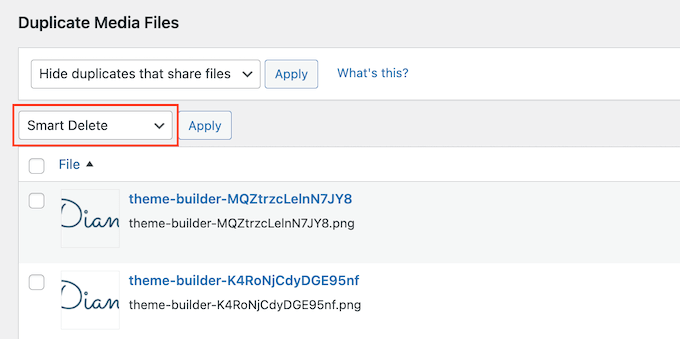
After that, check the box next to each image you want to remove and then click on the ‘Apply’ button. Media Deduper will go ahead and remove all these files.
The plugin will now monitor all the media you upload to WordPress. If it detects any duplicate files, then it will add them to the Media » Manage Duplicates screen automatically.
With that in mind, make sure you visit this screen occasionally to review and remove any unnecessary files.
Optimizing Your Media Files
Once you’ve deleted the duplicate images on your website, you should optimize the rest of your media files.
Many new website owners directly upload images from their phones and cameras. These high-quality images are often too big and take up a lot of storage space. This can make your backups bigger and affect WordPress speed and performance.
To fix this problem, we recommend resizing images. For more tips, see our step-by-step guide on optimizing mages for web performance before uploading them to your website. You can also use a WordPress image compression plugin to automatically optimize your media files without losing quality.
Video Tutorial
If you don’t like following written instructions, you can watch our video tutorial on how to clean up your WordPress media library instead:
We hope this article helped you learn how to clean up the WordPress media library. You may also want to see our beginner’s guide on how to set a default featured image in WordPress and our list of ways to prevent image theft in WordPress.
If you liked this article, then please subscribe to our YouTube Channel for WordPress video tutorials. You can also find us on Twitter and Facebook.





Mike
Great help! Thanks you!
WPBeginner Support
You’re welcome!
Admin
Dennis Muthomi
I manage multiple WordPress sites and I know how quickly the media library can get cluttered with unused images and duplicates. I also use the Media Deduper plugin on my clients sites. I started using it to automatically detect and remove duplicates and it’s freed up some hosting space. One other tip I would love to add is: set up a monthly task to scan and remove any new duplicates or unused media files to keep your library tidy over time.
Mrteesurez
This suites what I have wanted. I have many images on my site library that I want deleted, this guide is indeed helpful for me. I want to keep only currently used images on my site to reduce my disk space usage. If I used one image in two location, isn’t that a duplicate ?
WPBeginner Support
IF you use one image in two locations it would not be considered a duplicate.
Admin
Jiří Vaněk
Thanks for the advice. I need to reduce the size of my gallery, and I found out that many images in it are not used by my articles at all. It’s mainly about resizing the main images, where WordPress has made copies in different sizes. Since we’re talking about hundreds of images in my case, this will help me save a lot of space. I have the images backed up as the entire wp-content/upload folder, so there’s nothing to lose. I’m going to try it right away, and I’m curious to see how much space I can save.
Mrteesurez
This is exactly what happened to me, and it’s why I started looking for a solution. My media library had hundreds of unused images that were taking up valuable space, especially with Wordpress creating multiple copies in different sizes. When I finally resized and cleaned up my media library, I freed up a significant amount of space. It made a noticeable difference in my site’s performance. Having a backup like you do is key. I felt much more confident knowing I could safely experiment without losing any data. You’ll likely see a big improvement, both in terms of storage and how your site runs.
Jiří Vaněk
As for speed, I haven’t noticed any changes. I feel that WordPress does not slow down images that are not being used. However, WordPress sometimes has the unfortunate characteristic of creating multiple copies of each image. This can be prevented, according to another article here. I mainly addressed the issue due to space on my FTP and server. I have 1,300 articles on my website, and each has several images. This means that in my case, it involved thousands of images that were not being used, which takes up a significant amount of space. Otherwise, backups are absolutely crucial in this process because anything can go wrong, and especially, a person might delete something they didn’t intend to, and without a backup, they would be lost.
Greg
Hi there,
Thank you for this guide. I noticed the guide was updated in July 2023 but it appears Media Deduper hasn’t been tested for the last 3 major Wordpress updates and was last updated 5 months ago?
Is it still safe to use this?
Kind regards,
Greg
WPBeginner Support
When we tested the plugin for the update it was still working, for the concern with that message, we would recommend taking a look at our article below!
https://www.wpbeginner.com/opinion/should-you-install-plugins-not-tested-with-your-wordpress-version/
Admin
Mina
Thank you the article, it was very helpful. A quick question: can I uninstall the plugin after I am done? will uninstalling it reverts everything or it okey to remove the plugin after I am done using it?
WPBeginner Support
You can remove it after running it at the moment
Admin
Andi Schwartz
THANK YOU for this!! Saved me a TON of disk space cleaning up all the unused images!
WPBeginner Support
Glad our guide was helpful
Admin
Laurel
Thank you for this tutorial! It was so helpful!
WPBeginner Support
Glad our guide was helpful
Admin